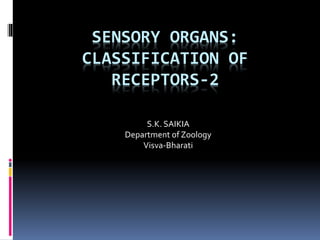
Classification of Sensory Receptors and Their Functions
- 1. SENSORY ORGANS: CLASSIFICATION OF RECEPTORS-2 S.K. SAIKIA Department of Zoology Visva-Bharati
- 2. Types of Receptors(based on location) Exteroceptors Detect stimuli near outer body surface Interoceptors Detect stimuli from inside the body Proprioceptors Detect stimuli deep within the body
- 3. Exteroceptors Cold Warmth Touch Pressure Special senses Hearing Vision
- 4. Exteroceptors Exteroceptors include a group of sensory receptors that detect any changes from the external environment. they are well positioned to respond to various stimuli that come from outside the body. Examples are vision, temperature changes, touch, smell and pain among others
- 5. Types of exteroceptors 1. Mechanoreceptors 2. Nociceptors 3. Proprioceptors 4. Thermoreceptors Exteroceptors
- 7. Mechanoreceptors A group of receptors located under the skin. These receptors respond to such physical changes as touch, vibration, stretch and pressure among others. Functionally, mechanoreceptors are a type of somatosensory receptors which relay extracellular stimulus to intracellular signal transduction through mechanically gated ion channels
- 8. Types of Mechanoreceptors Pacinian corpuscles Merkel complexes Meissner corpuscles Ruffini corpuscles
- 11. Pacinian corpuscle Source: Wikipedia Source: link.springer.com Source: https://neuromuscular.wustl.edu/
- 12. Pacinian corpuscle The Pacinian corpuscle has an onion-like capsule in which the inner core of membrane lamellae is separated from an outer lamella by a fluid-filled space. One or more rapidly adapting afferent axons lie at the center of this structure.
- 14. Merkel complexes The Merkel cell was discovered by F. S. Merkel in 1875 Merkel nerve endings are mechano- receptors, that are found in the basal epidermis and hair follicle. They are nerve endings and provide information on mechanical pressure, position, and deep static touch features, such as shapes and edges. The corpuscle is composed of a specific epithelial cell and an afferent axon terminal. Source: backyardbrains.com
- 15. Ruffini’s corpuscles The Bulbous corpuscle or Ruffini ending or Ruffini corpuscle is a slowly adapting mechanoreceptor located in the cutaneous tissue between the dermal papillae and the hypodermis. It is named after Angelo Ruffini, a histologist who first described the Bulbous corpuscle. This spindle-shaped receptor is sensitive to skin stretch, and contributes to the kinesthetic sense of and control of finger position and movement. They are at the highest density around the fingernails where they act in monitoring slippage of objects along the surface of the skin, allowing modulation of grip on an object
- 17. Meissner's corpuscles are a type of mechanoreceptor discovered by anatomist Georg Meissner (1829–1905) and Rudolf Wagner. This corpuscle is a type of nerve ending in the skin that is responsible for sensitivity to light touch Source: backyardbrains.com Source: UTHealth
- 18. The term “nociceptor” has been derived from the Latin “nocere,” which means to harm or to damage. A nociceptor (sensory neuron) that responds to damaging or potentially damaging stimuli by sending “possible threat” signals to the spinal cord and the brain. NOCICEPTORS Nociceptors are characterized by two distinctive features: (i) they are responsive preferentially to tissue threatening stimuli and encode their intensity, (ii) they mediate nocifensive motor and vegetative reactions by their central connections.
- 20. Proprioceptors Proprioception is the sense of knowing your body's relative position in space 1) These are the sensory receptors situated on the nerve endings of the inner, ear, muscles, skin, joints, tendon, and other tissues. 2) They relay information about our body's spatial position to the brain, the signals of which are translated into both large and subtle movements.
- 21. From Sports-health.com cdn.prod.openfit.com From Sports-health.com From: advancedathletics.com
- 22. From Slideshare
- 23. Thermoception or thermoreception is the sense by which an organism perceives temperatures. THERMORECEPTORS A thermoreceptor is a sensory receptor or, more accurately, the receptive portion of a sensory neuron that codes absolute and relative changes in temperature, primarily within the innocuous range.
- 24. Krause end bulb receptor which can detect cold Ruffini ending receptor which can detect warmth Thermoreceptors Capsule Receptors
- 25. Thermoreceptors Thermoreceptors: free nerve endings Thermal sensations: coldness and warmth Temperatures between 10 and 40C (50-105F) activate cold receptors located in the epidermis Temperatures between 32 and 48C (90- 118F) activate warm receptors located in the dermis Below 10C and above 48C stimulate nociceptors produce painful sensations
- 26. Interoceptors Interoceptors are receptors in your muscles and joints, there are also receptors inside your organs, including your skin.These receptors send information about the inside of your body to your brain. Interoception helps you understand and feel what’s going on inside your body. For instance, you know if your heart is beating fast or if you need to breathe more deeply.
- 27. Interoceptors Taste Smell pH Distension Spasm Flow
Editor's Notes
- Receptors in your muscles and joints tell you where your body parts are. That’s the basis for your proprioceptive sense, which makes you aware of where your body is in space. When you take a step, for example, you know your foot is off the ground without having to think about it. Interoception is a similar concept. Just as there are receptors in your muscles and joints, there are also receptors inside your organs, including your skin. These receptors send information about the inside of your body to your brain. This helps regulate our vital functions like body temperature, hunger, thirst, digestion, and heart rate. Interoception helps you understand and feel what’s going on inside your body. For instance, you know if your heart is beating fast or if you need to breathe more deeply. You’re able to tell if you need to use the bathroom. You know if you’re hungry, full, hot, cold, thirsty, nauseated, itchy, or ticklish.